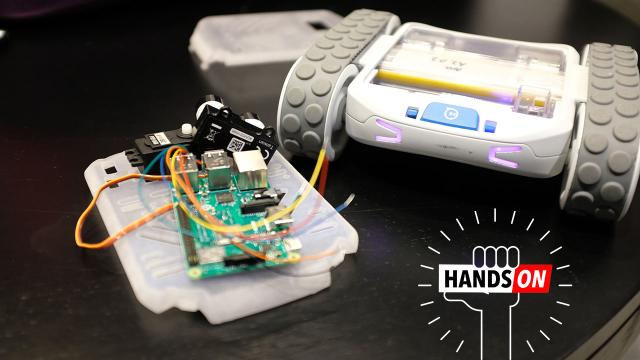You probably know Sphero best for licensed toys like the super-cute-but-now defunct BB-8 and other licensed bots. But its latest robot, the RVR (pronounced Rover) pushes forward with the company’s renewed focus on STEAM friendly robots, by adding a modular robot that can keep up with more advanced coders.
The RVR looks like a flat square with rounded edges and a pair of rubber, all-terrain treads. On the front, it’s got a cute “>_
That’s pretty nifty, and in a briefing, Sphero told me you could build anything from a bot that chases around your friends while shooting Nerf darts, to a more useful bot that delivers hot drinks around the office. That’s boosted in part by the RVR’s internal guts, which include sensors that can detect colour and ambient light. It’s also got your typical IR sensors, magnetometer, accelerometer, and gyroscope. It’s also got a 9-axis IMU (an inertial measurement unit; basically it can measure movement on 9 axes). It’s also got ambient light and colour sensors, which allow the RVR to send and receive signals from other Sphero robots.
The addition of a colour sensor is interesting and builds on Sphero’s new Specdrum sensor rings released at this year’s CES. It’s not a game-changer per se, but the option of adding new programming options is a solid addition when it comes to encouraging coders to think creatively—which is what you want.
Sphero Co-founder and Chief Creative Officer Adam Wilson told me that RVR was exactly the sort of robot he wanted growing up. Generally, most coding-oriented robots out there either frustrate users during the building process, or worse, are too single-function to stimulate creativity. According to Wilson, the RVR’s versatility and more advanced capabilities mean that it can keep up with developers’ imaginations.
Unlike Sphero’s Bolt, which is aimed at beginner coders, the RVR is also the company’s first bot meant to provide a more complex coding experience, while still being accessible to newbies. That’s evident in the RVR’s ability to connect to third-party hardware like Raspberry Pi, Micro:Bit, and Arduino.
Wilson likened it to the Misty Robot, a modular bot that was spun off from Sphero and is more interested in courting developers. And if that’s the case, then the RVR could be an interesting step forward for Sphero. That’s also part of the reason why Sphero is taking RVR to Kickstarter first—even though Sphero has enough credibility and experience to just release a product straight to consumers. “Right now we don’t really know what developers are looking for,” explained Wilson. “This is a good way to tap into a really active and passionate community and get some valuable feedback.”
In person, the RVR felt sturdy in my hands and surprisingly not that heavy. And while it drove around the Gizmodo office relatively smoothly, there were still a few connectivity quirks with the bot’s prototype app. Still, the modular plates super easy to swap on and off. That’s also intriguing in a classroom context, as you could theoretically have one base robot and tons of plates for students to work on simultaneously.
As of right now, you can back the robot on Kickstarter for $US200 ($281) and initial shipments are slated for September this year. After which, the retail price for the RVR will jump up to $US250 ($351) in the U.S.
